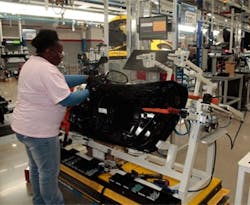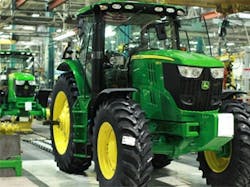Rethinking automatic guided vehicles
In brief:
- 40 years after the first large-scale AGV assembly projects, it may be time to take a fresh look at the technical and economic picture for AGVs and vehicle assembly.
- Exciting trends in guided vehicles suggest the pace of AGV deployment is about to accelerate into several new areas of manufacturing and distribution.
Manufacturers’ outlook
Watch videos of a dozen industry experts explaining how AGVs are impacting manufacturing and assembly.
What are the benefits of using automatic guided carts? Sarah Carlson, marketing director of Daifuku Webb, says automatic guided carts can be ergonomic, flexible and scalable.Through most of the 20th century it was said that everyone, anywhere in Detroit could hear the main chain. All activity, whether in stores or bars, in the media or schools, or even at home, was conducted with an ear to the slow parade of vehicles being pulled through assembly plants across the nation. Like an orchestra conductor or some giant’s heartbeat, the main chain at once enabled and constrained the activity of the whole manufacturing organism. It provided pace and efficiency for manufacturing flows, but it also limited operational flexibility.
For example, a standard way to produce a convertible car was to build a two-door hardtop, pull the unit off the assembly line, and then have a contractor cut the roof off and hand-build the unit as a convertible. This was a costly contortion of the vehicle assembly line, but car companies were trapped. Most convertible volume was too small to justify a dedicated assembly chain, or even a set of dedicated stations that would be lightly used. Clearly there had to be a better way to produce the specials, but the main chain made auto manufacturers slaves to volume.
Beginning in the early 1970s U.S. and European auto manufacturers began to experiment with automatic guided vehicles (AGVs) as a more flexible way to produce cars. In 1973, Volvo built a line of AGVs for their own use as platforms for auto assembly. Later they sold them to other auto manufacturers, as well. Soon several other manufacturers also offered wire-guided assembly vehicles, so-called because they were guided by wires buried, at great expense, in factory floors.
In the 1970s, the combination of cumbersome AGVs, equally cumbersome manufacturing cost accounting systems, and limited guidance and data processing technology made the great AGV experiment an interesting, but questionable economic exercise. The huge investment that U.S. auto manufacturers had in conventional, chain-driven assembly plants also slowed fundamental technological change.
Now, 40 years after the first large-scale AGV assembly projects, it may be time to take a fresh look at the technical and economic picture for AGVs and vehicle assembly. Important progress has been made in the vehicle assembly plants. Successful AGV applications are in place at Chrysler and John Deere. And exciting trends in guided vehicles suggest the pace of AGV deployment is about to accelerate into several new areas of manufacturing and distribution.
“We include AGVs in many aspects of material delivery, transportation of sub-assemblies between production lines, and in some cases also use AGVs to carry the sub-assemblies during their assembly,” says Didier Papin, head of Chrysler manufacturing engineering and general assembly. “We have not used AGVs to carry complete bodies on assembly lines. For our main line assembly, we have existing conveyor solutions already in place and have not considered AGVs as a replacement.”
Figure 1. AGVs play many roles at Chrysler, including delivery of material from the receiving dock to the assembly line delivery from sequence/kitting areas to the assembly line. Nearly 150 employees hand-build 12 SRT Viper muscle cars each day at Chrysler’s Conner Avenue Assembly Plant in Detroit.
AGVs play a key role in delivering material from the receiving dock to the assembly line at Chrysler. “They also deliver sequenced and kitted material from sequence/kitting areas to the assembly line,” says Papin. “ The use of AGVs in this manner allows us to deliver material efficiently.”
{pb} Is your automated guided vehicle being used to its full potential? Mark Longacre, marketing manager at JBT, says AGVs can move anything from raw materials to manufactured goods and much more.At Chrysler’s Belvidere Assembly Plant, conveyor deck AGVs deliver engines and transmissions directly from the receiving dock to the assembly line and tugger style AGVs deliver sheet metal body parts from an automated storage retrieval system (ASRS) in the stamping area to staging areas in the body shop. At the Brampton Assembly Plant, fork style AGVs deliver sheet metal body parts from laydown areas near the dock to laydown areas in the body shop. And at the Jefferson North Assembly Plant, tugger style AGVs deliver up to four bulk part containers on carts from a dock laydown area to a laydown area in trim chassis final.
“Chrysler has used several AGV manufacturers over the years, including JBT, Auto-Craft, Egemin, and Jervis B. Webb,” says Papin. “Manufacturers are chosen based on technological requirements for the application. Application-specific considerations include part weight, container size, and pickup and delivery locations, as well as interface between the assembly operator and the parts.”
Several Chrysler plants have shown valuable results by integrating AGVs into production and assembly operations that use traditional main chain assembly for finished vehicles. Repetitive material moves are being intelligently handled by a variety of automated solutions. Papin credits ongoing technological development with the progress of AGVs into Chrysler operations.
“The biggest technological advances in AGVs have been in the area of improved guidance systems,” continues Papin. “The advantage to these advances is increased flexibility. With the latest guidance systems, we have the ability to change AGV routes or paths in real time without making any facility changes.”
Chrysler started out using magnetic guidance systems which required that a magnetic bar be embedded into the concrete floor, explains Papin. “From there we advanced to putting magnetic tape on the floor or using optical guidance where the AGV followed a paint stripe on the floor,” he says. “These methods of guidance are still used today; however, they are somewhat inflexible when there is a need to change an AGV route or repurpose an AGV system for a different operation. Laser guidance uses reflective targets mounted along the AGV path. The AGV uses a laser to identify its location along the path based on the location of the targets. This system allows for greater flexibility in changing the guide path. However, changes to the guide path are limited based on the location of the reflective targets in the facility.”
The latest Inertial guidance technology offers complete guide path flexibility, says Papin. “An inertial sensor is used to maintain its position through a virtual path,” he explains. “Guide path changes can be made with a simple personal computer program. The next step is the use of open path navigation. The AGV is programmed to move from Point A to Point B, but the path that it takes is not specified. The vehicle determines its own path.”
While Chrysler strikes a pragmatic balance between integration of new technology and ongoing use of existing infrastructure, cutting-edge users explore other areas of AGVs’ flexibility. At the John Deere Tractor Works in Waterloo, Iowa, AGVs move units in and out of the production flow and support an exciting quality approach (Figure 2).
Figure 2. AGVs move units in and out of the production flow and support an exciting quality approach at John Deere’s Tractor Cab Assembly in Waterloo, Iowa, where the 6R tractor comes rolling off the line.
“When a repair is required, this allows flexibility to enforce ‘no fault forward (NFF)’ because it requires a manufacturing engineer to override the system to move to the next station,” says Thad Nevitt, factory manager. “Because the AGV system allows for lock-out, we are able to prevent the cab from moving to the next stage in the process, such as final assembly, until all quality defects have been closed out of the system. This in turn reduces disruption to subsequent stations.”
Cabs can be pulled out of line into repair areas but cannot be advanced down the line until they meet Deere’s quality standards. Unlike a main chain, though, an empty space is not created in the assembly operation. A cab can be pulled out of line and reinserted without serious disruption of production flow.
The John Deere system also supports a great deal of variety among tractor cabs traveling through the cab assembly area. This permits workload leveling across several model lines and a broad range of cab appointments and options.
“You can program logic into a PLC that interfaces with Avinu — the AGV system — to make a decision to travel a certain direction when it arrives at a fork,” says Nevitt. “For example, we have several end-of-line testers that are specific to a model of a tractor. Avinu and the PLC can direct the AGV to go to the appropriate tester.”
Assembly techs work in the area that makes sense for the work that is assigned to them, explains Nevitt. “Typically, we are able to keep them busy between one or two stations,” he says. “AGVs do help smooth the flow of the line because we run a mix of different cabs with IPK stations built in to allow for a little variability in cycle time from cab to cab. It also improves the ergonomics because we no longer need to push the cab from station to station.”
AGV flexibility is supporting zero-defect production in a new way. Instead of stopping the line until a fault is corrected, it sets the unit aside to be properly addressed without serious damage to plant productivity. Similarly exotic options or unusual testing requirements can be addressed without sending a ripple down the assembly line.
Want to learn more about AGVs? Read Stanton's blog post, AGVs stretch manufacturing cells' flexibility.



